With the development of society and economic growth, energy supply has become an indispensable and important factor in modern industrial production. The selection of heating schemes in industrial sites in mining areas is of great significance for ensuring production safety, improving production efficiency, and achieving sustainable development. This article will conduct a comprehensive analysis of the heating scheme for industrial sites in mining areas.
1、 Selection of heating methods
Oil and gas heating: Oil and gas heating is currently one of the more common heating methods. It transfers the heat generated by the combustion of fuels such as fuel or natural gas to the heat source equipment in industrial sites for heating. The advantages of this method are simple operation, high thermal efficiency, and low combustion pollution. However, oil and gas heating requires a large amount of fuel, and the price is also high. The storage, transportation, and processing of fuel can also generate certain environmental pollution, so it is not suitable in some regions.
Electric heating: Electric heating is a way of using electricity as energy for heating. This method is simple to operate and pollution-free. However, electric heating requires a large amount of electricity, and the electricity price is relatively high. If the power supply of industrial sites in mining areas is insufficient, it will affect the normal operation of production.

2、 Selection of heating equipment
Gas boiler: A gas boiler is a device that converts the heat energy generated by the combustion of natural gas, liquefied gas, or other gases into hot water or steam, and then transports it through pipelines to heating equipment for heating. Gas boilers have advantages such as high safety, good environmental protection, and long service life, but they require high investment costs.
Oil fired boiler: Oil fired boiler is a type of equipment that converts the heat energy generated by fuel combustion into hot water or steam, and then delivers it to heating equipment through pipelines for heating. It has advantages such as high thermal efficiency and long service life, but requires regular cleaning and maintenance, and the price of fuel is relatively high.
Electric boiler: Electric boiler is a type of equipment that uses electrical energy for heating, converts heat energy into hot water or steam, and then transports it through pipelines to heating equipment for heating. It has the advantages of safe use, low pollution, and no need to store fuel, but it requires a large amount of electricity supply and relatively high electricity costs.
Exhaust air heat pump heating: Exhaust air heat pump heating is a new environmentally friendly heating method. It uses a low-temperature waste heat source (exhaust air in the mine ventilation system) as the heat source, and uses heat pump technology to raise the low-temperature heat energy to the temperature required for heating. The exhaust heat pump heating has the following advantages: firstly, it is a clean energy utilization method that reduces dependence on traditional energy and environmental pollution. Secondly, it has high energy utilization efficiency, which can save energy consumption and operating costs. In addition, the structure of the exhaust air heat pump heating system is relatively simple, and the maintenance cost is low.
When selecting heating equipment, it is necessary to comprehensively consider factors such as investment cost, service life, safety, and environmental friendliness to choose a suitable heating equipment. At the same time, regular equipment cleaning and maintenance are also required to ensure the normal operation of the equipment. The selection of heating schemes for industrial sites in mining areas requires comprehensive consideration of multiple factors, selection of suitable heating methods and equipment, and regular maintenance and management of equipment to ensure heating efficiency and production safety.







Comment